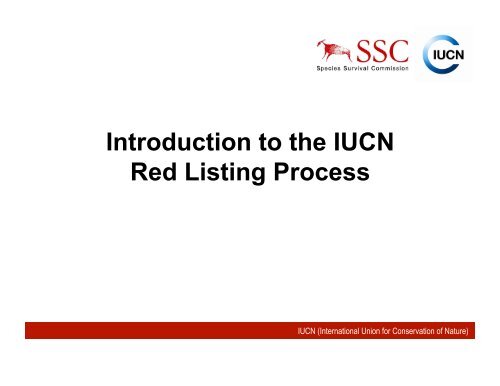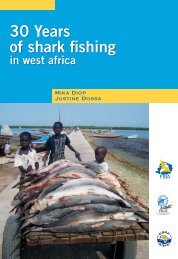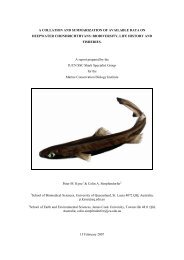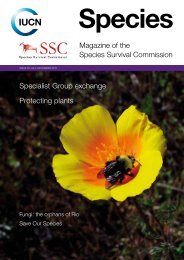Introduction to the IUCN Red Listing Process
Introduction to the IUCN Red Listing Process
Introduction to the IUCN Red Listing Process
You also want an ePaper? Increase the reach of your titles
YUMPU automatically turns print PDFs into web optimized ePapers that Google loves.
<strong>Introduction</strong> <strong>to</strong> <strong>the</strong> <strong>IUCN</strong><br />
<strong>Red</strong> <strong>Listing</strong> <strong>Process</strong><br />
<strong>IUCN</strong> (International Union for Conservation of Nature)
What is <strong>the</strong> likelihood of a species becoming<br />
extinct in <strong>the</strong> near future, given current<br />
knowledge about population trends,<br />
range, and recent, current or<br />
projected threats?<br />
<strong>IUCN</strong> (International Union for Conservation of Nature)
The<br />
<strong>IUCN</strong><br />
Categories<br />
Extinct (EX)<br />
Extinct in <strong>the</strong> Wild (EW)<br />
Critically Endangered (CR)<br />
Endangered (EN)<br />
Vulnerable (VU)<br />
Near Threatened (NT)<br />
Least Concern (LC)<br />
Data Deficient (DD)<br />
Not Evaluated (NE)<br />
<strong>IUCN</strong> (International Union for Conservation of Nature)
Near Threatened (NT)<br />
A taxon is Near Threatened when it has been evaluated<br />
against <strong>the</strong> criteria and does not qualify for CR, EN or VU<br />
now, but is close <strong>to</strong> qualifying for<br />
or is likely <strong>to</strong> qualify for a threatened<br />
category in <strong>the</strong> near future.<br />
Least Concern (LC)<br />
Pho<strong>to</strong> © H. Fraga<br />
Macaronesian Laurel, Laurus azorica<br />
A taxon is Least Concern when it has been evaluated against<br />
<strong>the</strong> criteria and does not qualify for CR, EN,<br />
VU or NT. Widespread and abundant taxa<br />
are included in this category.<br />
Pho<strong>to</strong> © Caroline Pollock<br />
<strong>IUCN</strong> (International Union for Conservation of Nature)<br />
Olive Baboon, Papio anumbis
Data Deficient (DD)<br />
Tree Toma<strong>to</strong><br />
Solanum [Cyphomandra] betacea<br />
Not Evaluated (NE)<br />
<strong>IUCN</strong> (International Union for Conservation of Nature)
Data Deficient (DD)<br />
Not Evaluated (NE)<br />
Although DD and NE are not<br />
threatened categories, taxa classed<br />
as DD or NE should NOT be treated as<br />
not threatened<br />
<strong>IUCN</strong> (International Union for Conservation of Nature)
Types of data required for<br />
<strong>IUCN</strong> <strong>Red</strong> List assessments<br />
<strong>IUCN</strong> (International Union for Conservation of Nature)
Dealing with a lack of high<br />
quality data<br />
• The threatened categories use<br />
quantitative thresholds<br />
• BUT a lack of high quality data should<br />
not deter assessors from applying <strong>the</strong><br />
<strong>IUCN</strong> criteria.<br />
<strong>IUCN</strong> (International Union for Conservation of Nature)
<strong>IUCN</strong> (International Union for Conservation of Nature)
<strong>IUCN</strong> (International Union for Conservation of Nature)
<strong>IUCN</strong> (International Union for Conservation of Nature)
Concepts and definitions<br />
underlying <strong>the</strong> <strong>IUCN</strong> <strong>Red</strong> List<br />
Categories and Criteria<br />
<strong>IUCN</strong> (International Union for Conservation of Nature)
Key terms used in <strong>the</strong> <strong>IUCN</strong> <strong>Red</strong><br />
List criteria<br />
<strong>IUCN</strong> (International Union for Conservation of Nature)
<strong>IUCN</strong> (International Union for Conservation of Nature)
<strong>IUCN</strong> (International Union for Conservation of Nature)
<strong>Red</strong>uction is a decline in population<br />
size of at least <strong>the</strong> % stated in criterion<br />
A over <strong>the</strong> specified time period.<br />
Population<br />
Size<br />
Time<br />
<strong>IUCN</strong> (International Union for Conservation of Nature)
Extent of Occurrence is <strong>the</strong> area<br />
contained within <strong>the</strong> shortest<br />
continuous imaginary boundary<br />
which can be drawn <strong>to</strong> encompass<br />
all known, inferred, or projected sites<br />
presently occupied by <strong>the</strong> taxon.<br />
<strong>IUCN</strong> (International Union for Conservation of Nature)
<strong>IUCN</strong> (International Union for Conservation of Nature)
Invasive<br />
species<br />
2 locations<br />
<strong>IUCN</strong> (International Union for Conservation of Nature)
Pollution<br />
4 locations<br />
<strong>IUCN</strong> (International Union for Conservation of Nature)
4-5<br />
locations<br />
Pollution<br />
<strong>IUCN</strong> (International Union for Conservation of Nature)
The <strong>IUCN</strong> <strong>Red</strong> List Criteria<br />
<strong>IUCN</strong> (International Union for Conservation of Nature)
A<br />
CRITERIA<br />
Nature of <strong>the</strong> Criteria<br />
Population<br />
reduction<br />
THREATENED<br />
CATEGORIES<br />
B<br />
Restricted<br />
geographic range<br />
Critically Endangered (CR)<br />
C<br />
Small population<br />
size & decline<br />
Quantitative<br />
thresholds<br />
Endangered (EN)<br />
D<br />
E<br />
Very small or<br />
restricted<br />
population<br />
Quantitative<br />
analysis<br />
Vulnerable (VU)<br />
<strong>IUCN</strong> (International Union for Conservation of Nature)
Why use multiple criteria?<br />
Not all <strong>the</strong> criteria are appropriate <strong>to</strong> all taxa.<br />
• All taxa being assessed must be evaluated<br />
against each criterion.<br />
• Meeting any one of <strong>the</strong> criteria qualifies a<br />
taxon for listing at that level of threat<br />
• All criteria met at <strong>the</strong> highest level of threat<br />
should be listed.<br />
<strong>IUCN</strong> (International Union for Conservation of Nature)
Criterion A<br />
Past, present or future population reduction<br />
Population<br />
Size<br />
Time<br />
<strong>IUCN</strong> (International Union for Conservation of Nature)
Criterion A<br />
Based on any of four criteria:<br />
A1: Population reduction in past and causes of<br />
decline now ceased<br />
A2: Population reduction in past and causes of<br />
decline ongoing<br />
A3: Population reduction expected in future<br />
A4: Population reduction in past AND future<br />
<strong>IUCN</strong> (International Union for Conservation of Nature)
Criterion A<br />
Managed harvest species<br />
(e.g., fisheries)<br />
Taxa that are <strong>the</strong> target of large-scale harvesting may show a decline in population size due<br />
<strong>to</strong> intentional management actions. Such taxa could be assigned a threatened status under<br />
criterion A.<br />
Concern has been expressed that such a listing might not reflect extinction risk, especially if<br />
<strong>the</strong> decline is a consequence of a management plan designed <strong>to</strong> maximize sustainable<br />
yield from a fishery.<br />
BUT, if <strong>the</strong> fishery is managed effectively, although it currently shows symp<strong>to</strong>ms consistent<br />
with endangerment, <strong>the</strong> population will eventually stabilize at a target level and <strong>the</strong> decline<br />
will end, such that <strong>the</strong> taxon would <strong>the</strong>n no longer qualify for listing. If declines continued,<br />
<strong>the</strong>re would be good reason for concern, and <strong>the</strong> listing would still apply.<br />
Taxa that are targeted by sustainably managed fisheries should be assessed under criterion<br />
A1, where <strong>the</strong> higher thresholds make it less likely that <strong>the</strong>y will be classified as threatened.<br />
<strong>IUCN</strong> (International Union for Conservation of Nature)
Criterion A1<br />
past reduction & causes<br />
unders<strong>to</strong>od & ceased &<br />
reduction is reversible<br />
Present<br />
Last 10 years or 3 generations<br />
(whichever is longer)<br />
Criterion A2<br />
past reduction & causes<br />
may not be unders<strong>to</strong>od<br />
or may not have ceased<br />
or reduction may not be<br />
reversible<br />
Present <strong>IUCN</strong> (International Union for Conservation of Nature)<br />
Last 10 years or 3 generations<br />
(whichever is longer)
Sub-criterion A3<br />
future decline<br />
Present<br />
Next 10 years or 3 generations<br />
(whichever is longer up <strong>to</strong> a maximum of 100<br />
years)<br />
Sub-criterion A4<br />
past & future<br />
Present<br />
10 years or 3 generations <strong>IUCN</strong> (International Union for Conservation of Nature)<br />
(whichever is longer, up <strong>to</strong> a maximim of 100 years in <strong>the</strong> future)<br />
including some time in <strong>the</strong> past AND in <strong>the</strong> future
Sub-criterion A4<br />
past & future: “shifting time window”<br />
10 years 10 / 3 years generations 10 / 3 years generations / 3 generations<br />
6.65 years 3.3 / 2 years 1.5 / 1 3.356.6 years years / / 11.5<br />
/ 2<br />
generations generation<br />
generations<br />
Present<br />
<strong>IUCN</strong> (International Union for Conservation of Nature)
For ALL <strong>the</strong> criteria (A1–A4), rate of population<br />
reduction should be based on any of:<br />
(a) Direct observation (not for sub-criterion A3 – future reduction)<br />
(b) An index of abundance appropriate <strong>to</strong> <strong>the</strong> taxon.<br />
(c) A decline in:<br />
• area of occupancy;<br />
• extent of occurrence; and/or<br />
• quality of habitat.<br />
(d) Actual or potential levels of exploitation.<br />
(e) The effects of:<br />
• introduced taxa<br />
• hybridization<br />
• pathogens<br />
• pollutants<br />
• competi<strong>to</strong>rs<br />
• parasites<br />
<strong>IUCN</strong> (International Union for Conservation of Nature)
Criterion A<br />
<strong>IUCN</strong> (International Union for Conservation of Nature)
Criterion B<br />
Restricted geographic range and<br />
fragmentation, continuing decline or extreme<br />
fluctuations<br />
<strong>IUCN</strong> (International Union for Conservation of Nature)
Criterion B<br />
Based on ei<strong>the</strong>r of two sub-criteria:<br />
B1: Estimated extent of occurrence<br />
AND / OR<br />
B2: Estimated area of occupancy<br />
AND at least TWO of a-c:<br />
a. Severely fragmented or few locations<br />
b. Continuing decline<br />
c. Extreme fluctuations<br />
<strong>IUCN</strong> (International Union for Conservation of Nature)
Criterion B<br />
Subcriterion B1<br />
Extent of occurrence<br />
estimated <strong>to</strong> be:<br />
Subcriterion B2<br />
Area of occupancy<br />
estimated <strong>to</strong> be:<br />
CR<br />
EN<br />
VU<br />
<strong>IUCN</strong> (International Union for Conservation of Nature)
Criterion B<br />
AND at least TWO of a, b or c:<br />
CR<br />
EN<br />
a. Severely<br />
fragmented or<br />
# locations:<br />
VU ≤ 10<br />
b. Continuing decline in<br />
any of <strong>the</strong> following:<br />
(i) EOO<br />
(ii) AOO<br />
(iii) Area, extent and/or<br />
quality of habitat<br />
(iv) # locations or<br />
subpopulations<br />
(v) # mature individuals<br />
c. Extreme fluctuation in<br />
any of <strong>the</strong> following:<br />
(i) EOO<br />
(ii) AOO<br />
(iii) # locations or<br />
subpopulations<br />
(iv) # mature individuals<br />
<strong>IUCN</strong> (International Union for Conservation of Nature)
Criterion B<br />
Points <strong>to</strong> remember:<br />
• Subcriterion B1 is based on extent of occurrence, while subcriterion<br />
B2 is based on area of occupancy.<br />
• Ei<strong>the</strong>r subcriteria B1 or B2, or both may apply.<br />
• To fully qualify for a listing under criterion B, <strong>the</strong> taxon must meet at<br />
least two of <strong>the</strong> subcriteria a, b or c. (fragmentation, decline, fluctuation)<br />
• Subcriterion B1a / B2a may be based on ei<strong>the</strong>r severe fragmentation<br />
OR number of locations – please remember <strong>the</strong> definitions of <strong>the</strong>se<br />
terms when applying <strong>the</strong>m.<br />
<strong>IUCN</strong> (International Union for Conservation of Nature)
Popondetta Blue-eye (<br />
Pseudomugil connieae)<br />
Vulnerable B1ab(iii)<br />
Justification:<br />
Assessed as Vulnerable due <strong>to</strong> its restricted extent of occurrence,<br />
which is 15,927 km². This species occurs in only three locations, (three<br />
river systems). Two of <strong>the</strong>se locations are threatened by urban<br />
encroachment. In addition, P. connieae is threatened by a continuing<br />
decline in habitat quality, due <strong>to</strong> logging, and an increase in agriculture<br />
and urbanization in <strong>the</strong> region of Popondetta.<br />
<strong>IUCN</strong> (International Union for Conservation of Nature)
Subcriterion B1<br />
Extent of occurrence<br />
estimated <strong>to</strong> be:<br />
Subcriterion B2<br />
Area of occupancy<br />
estimated <strong>to</strong> be:<br />
CR<br />
EN<br />
VU<br />
<strong>IUCN</strong> (International Union for Conservation of Nature)
AND at least TWO of a, b or c:<br />
CR<br />
EN<br />
a. Severely<br />
fragmented or<br />
# locations:<br />
VU ≤ 10<br />
b. Continuing decline in<br />
any of <strong>the</strong> following:<br />
(i) EOO<br />
(ii) AOO<br />
(iii) Area, extent and/or<br />
quality of habitat<br />
(iv) # locations or<br />
subpopulations<br />
(v) # mature individuals<br />
c. Extreme fluctuation in<br />
any of <strong>the</strong> following:<br />
(i) EOO<br />
(ii) AOO<br />
(iii) # locations or<br />
subpopulations<br />
(iv) # mature individuals<br />
<strong>IUCN</strong> (International Union for Conservation of Nature)
















